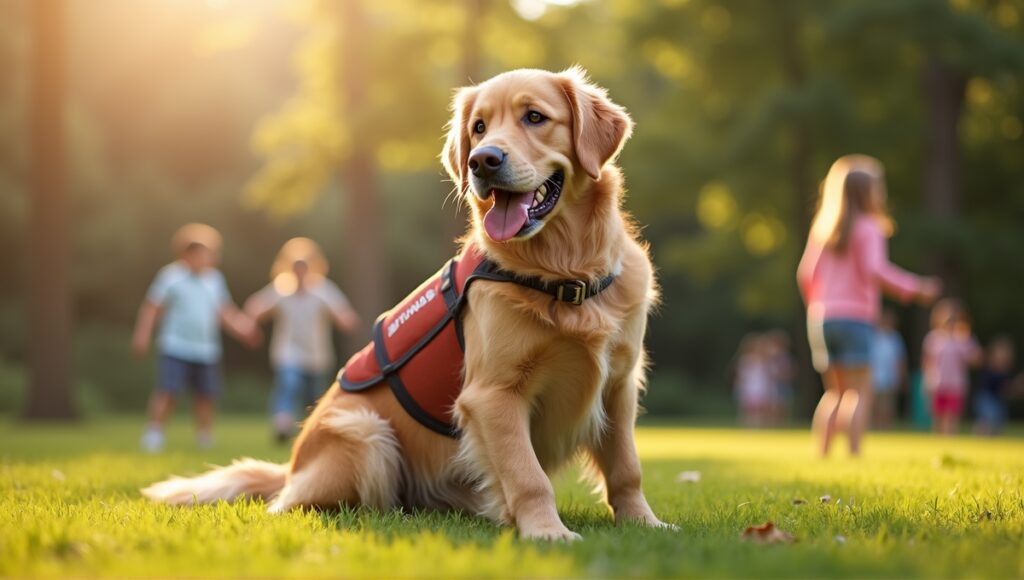Therapy dogs breeds offer comfort and companionship to those who need it most. I’ve personally witnessed how these loyal four-legged friends can change people’s lives. Golden Retrievers, Labrador Retrievers, and Poodles are common breeds selected for therapy dogs because they’re gentle and enjoy being around people. However, what truly matters for a therapy dog is their temperament and training, not their breed.
Popular Therapy Dog Breeds

Therapy dogs can be any breed, and in my years of experience training dogs for therapy work, I’ve learned which breeds make the best therapy dogs. Here are a few of the most common therapy dog breeds:
- Golden Retrievers: They’re friendly, gentle, and have a natural love for people. Their laid-back attitude and patience make them one of the best therapy breeds.
- Labrador Retrievers: Labs are the most outgoing and eager to please of any breed. They also have an almost magical ability to read emotions, making them excellent at comforting others.
- Poodles: Poodles are extremely intelligent and hypoallergenic. They can adapt to any therapy environment, and their non-shedding coat is a plus if visiting hospitals.
- Cavalier King Charles Spaniels: These smaller dogs are sweet and gentle. They’re the perfect size for therapy work with kids and other tight spaces.
- German Shepherds: German Shepherds are extremely loyal and protective, making them great at therapy roles where someone just needs to feel safe and secure, such as someone with PTSD.
- Greyhounds: Greyhounds are calm and relaxed in any setting. They make excellent therapy dogs despite their background as racers.
- Pugs: Pugs are just plain funny and love to entertain. They’re excellent therapy dogs because they make people laugh, and laughter is the best medicine.
These breeds are commonly found in therapy programs, but remember, any dog can be a therapy dog as long as it has the right personality. For families looking for affectionate companions, consider exploring more about best small family dogs.
Characteristics of Effective Therapy Dogs
From my experience working with therapy dogs, I can tell you there are a few key traits needed to succeed in this role. Here are the qualities of an effective therapy dog:
- Calm and gentle demeanor: The dog should be calm in all situations.
- Social and people-loving: The dog should genuinely enjoy people.
- Ability to change environments: You never know what a therapy environment will look like.
- Patient and tolerant: The dog should be able to tolerate unexpected touches and pats.
- Good with children and elderly: The dog should be gentle with anyone they encounter.
- Non-aggressive: If the dog shows any aggression, they aren’t a fit for therapy work.
- Highly trained and obedient: The dog should reliably follow basic commands.
These qualities ensure that therapy dogs can provide comfort and support without causing the person they’re supposed to comfort stress or anxiety.
Training and Certification for Therapy Dogs
Training a therapy dog is a journey I’ve been through many times. It’s a fulfilling experience, but it does require commitment. Here’s what the process usually looks like:
- Basic obedience training: Training basic commands such as sit, stay, come, and leave it.
- Socializing and exposure: Introducing the dog to different people, environments, and experiences.
- Therapy training: Training the dog to be calm while being pet and handled by others.
- Certification organizations: There are various organizations, such as Pet Partners and Therapy Dogs International.
- Evaluation process: Dogs are tested on obedience and how they react to various situations.
- Continued training: Regular training and practice to keep the dog sharp and comfortable in new situations.
- Recertification: Re-evaluating the dog every so often to ensure it still meets the organization’s therapy dog standards.
Keep in mind certification requirements may vary by organization. Always consult the specific organization you’re interested in to learn about its process.
Therapy Dogs vs. Service Dogs vs. Emotional Support Animals
It’s important to know the differences between these three types of support animals:
| Aspect | Therapy Dogs | Service Dogs | Emotional Support Animals |
|---|---|---|---|
| Purpose | Provides comfort to many people | Helps one individual with tasks | Provides comfort to one person |
| Access Rights | Limited access to public places | Full access to public places | Housing access rights only |
| Training | General obedience and task-specific therapy training | Extensive task-specific training | No specific training required |
| Certification | Required | Not required by law, but most have one | Not required |
Each type of support animal has a different purpose.
- Therapy dogs bring comfort to many people,
- service dogs help an individual with tasks,
- and emotional support animals provide comfort to a single person.
Benefits of Therapy Dogs

I’ve seen firsthand the amazing benefits therapy dogs offer. Here are some of the main benefits:
- Stress reduction: Interacting with therapy dogs reduces blood pressure and cortisol levels
- Improved mood: Dogs elevate serotonin and dopamine levels, which makes people feel happier
- Social interaction: Therapy dogs act as social catalysts that encourage interaction
- Physical health: Petting a dog reduces heart rate and can even enhance immune function
- Medical benefits: In a hospital, therapy dogs can lower pain and expedite recovery
- Educational benefits: In a school, therapy dogs can enhance reading skills and classroom behavior
These benefits are why therapy dogs are growing in popularity in various environments. They’re not just adorable; they’re also powerful tools for improving human health. Additionally, if you’re looking for an adorable companion that fits well into family dynamics, you may want to learn about small mixed breed dogs.
Choosing the Right Therapy Dog Breed
It’s important to choose the right breed for therapy work. Here’s what to consider:
- Target environment: Some breeds may excel in specific environments more than others.
- Your lifestyle: Select a breed that matches your energy and living space.
- Breed traits: Look at characteristics of specific breeds that make them great therapy dogs.
- Size and grooming: Think about the size of the dog and its grooming needs.
- Expert advice: Speak with therapy dog organizations about the best breeds.
Remember any breed can potentially become a therapy dog. The individual dog’s temperament is more important than its breed.
Therapy Dog Work Environments
Therapy dogs operate in various settings, each with its own set of challenges and benefits:
- Hospitals: Comforting patients and families during challenging times
- Nursing homes: Providing company and happiness to elderly residents
- Schools: Assisting students with learning or emotional difficulties
- Libraries: Helping children boost their reading skills in a non-judgmental environment
- Disaster areas: Comforting victims and first responders in times of crisis
- Airports: Calming anxious travelers and alleviating stress
These different settings demonstrate the flexibility of therapy dogs. They can accommodate various needs and provide comfort wherever they’re located.
Preparing a Dog for Therapy Work

The preparation to make a dog a therapy dog begins early. Here’s how:
- Early socialization: Introduce puppies to as many different people, places, and sounds as possible.
- Positive reinforcement: The more positive reinforcement you use to train your dog, the better.
- Health and grooming: Regular vet visits and proper grooming are a must.
- Stress management: Training the dog to handle potentially stressful situations.
- Handler bond: Establish a strong relationship of trust with your dog.
- Veterinary care: Make sure all required vaccinations and health checks are in place.
Proper early socialization during a puppy’s first few weeks can help avoid anxiety or behavioral problems down the road. All of this early preparation lays the groundwork for a successful therapy dog.
Becoming a therapy dog is a journey, so be patient, stay dedicated, and continue pouring your love into the dog. The endless satisfaction you’ll receive from watching your dog provide comfort and joy to others is why so many therapy dog owners find it’s all worth it.
In Summary
Therapy dogs are incredible assistants and they can be any breed of dog that possesses general traits of calmness, patience, and a love for people. Training is essential. It requires a significant amount of effort to train a dog to become a therapy dog.
Therapy dogs are not the same as service dogs or emotional support animals, each of which has its own role and regulations. The benefits of therapy dogs are extensive. They help reduce stress, lift spirits, and can even provide various physical health benefits.
Selecting and training a therapy dog requires careful consideration and effort. However, it’s incredibly rewarding as these dogs bring joy and comfort to countless people in need.






